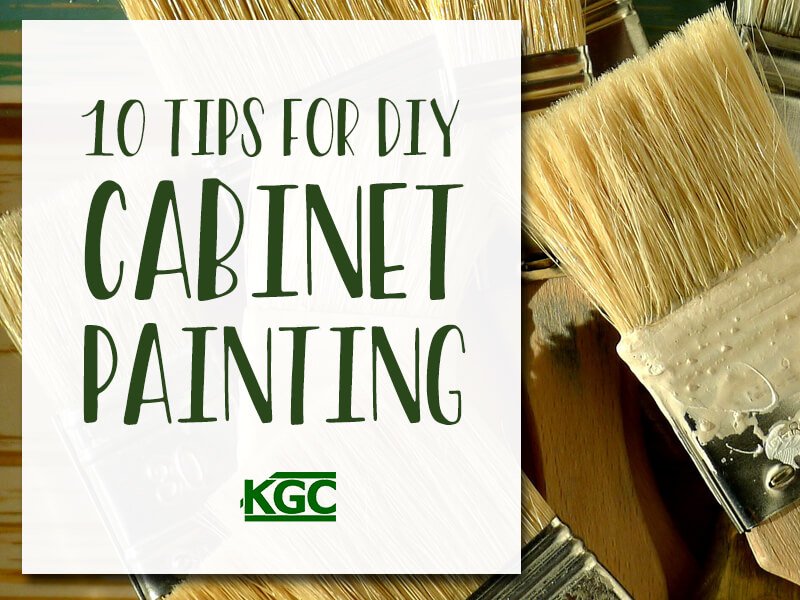For some of us, a redesigned kitchen is what dreams are made of. Expensive dreams.
But did you know that can completely transform your kitchen and give incredible results, for a fraction of the price: repainting your own kitchen cabinets.
DIY cabinet painting won’t last as long as a professional refacing job or a complete kitchen remodel, but a fresh coat of paint can give your kitchen a completely new lease of life.
It’s not for the faint of heart, and not for all kitchens, but if you’re going to give it a go, read these tips first.
1. Choose the right paint (and color)
Repainting cabinets can give your kitchen a completely new look, so the paint color and quality is really important.
We can’t overemphasize how vital good quality and durable paint is for kitchens: oil and acrylic primers and enamels work well. The paint needs to look good for years, throughout all the cooking, cleaning and wear and tear.
There’s a wide range of high-quality paint options these days, some even waterproof and mold resistant – get advice from your local Oregon DIY store.
Choose a color that will add a pop or one that will match your appliances and countertops, blending well with them or complementing them.
You’ll want a color that will stand the test of time: what was trendy 10 years ago now may just look dated. Choose the wrong color, and it won’t just be you who’ll tire of your kitchen: it may be potential house buyers, too.
Many people play it safe and choose neutral colors, but don’t be afraid to try something brighter that will truly make it feel like home sweet home. You can always repaint the cabinets if you decide to sell up or simply change the style.
2. Give yourself a few days
DIY painting, even if you’re an old hand, takes time. Even for small kitchens.
You’ll need several days for several coats, and organizing your family around this kind of job can be a task on its own.
Cook a few things in advance or plan a few outings to restaurants—you won’t be using your kitchen for a few days!
3. Prep your kitchen area
Does painting sound like fun? Think again! There’s an awful lot of work involved, and prepping your kitchen area is key to hassle-free painting.
Repainting kitchen cabinets is a big task, so prepare well in advance:
- Remove everything from the kitchen that can easily be removed (accessories, anything hanging around the counters).
- Protect the floor, counters, tables, and appliances with brown paper or similar.
- Remove/unscrew drawers, doors, pulls, and handles from all cabinets.
- Remove or seal off anything in the cabinets.
- Apply masking tape to every edge of the kitchen that the cabinet touches.
- Clean all surfaces of your cabinets and remove all traces of grease.
- De-fuzz your roller (new or old). You can do this with masking tape, giving it a few squeezes before you unwrap it from the roller.
4. Number your pieces
Skipping this step is perhaps one of the biggest regrets of DIY enthusiasts. Once the cabinet doors, shelves, drawers, pulls and handles (and all their respective screws) are out and strewn about, it can be a really tough puzzle to put them back together again.
How to avoid this headache? Make a rough drawing of your kitchen, and give each cabinet, door, and drawer a number, working your way through the kitchen layout. Then use masking tape and a marker to write down the same number on the matching cabinet, door, and drawer.
Next, remove the hinges and pulls and write their cabinet number on it, then put it in a Ziploc bag along with any screws and bolts. Every cabinet gets its own bag.
When it comes to putting everything back together again, you’ll have a handy diagram and all the bits and pieces in one place, ready to go.
5. Decide to sand or not to sand
Experts are divided over the issue of sanding the cabinet doors or not.
Some prefer to sand the cabinets so that the primer sticks better (also helped by having a thoroughly grease-less cabinet!). Others feel that sanding down wood makes the cabinet more vulnerable to moisture and bacteria.
The general consensus is that if the old paint is chipping or damaged, or if you want to change how the surface of the cabinet looks, then you’re probably better off sanding. Also sand if you’re going to use water-based primer.
Sand lightly (or not at all) if your cabinets are bare wood or have a factory finish, as the paint will likely adhere quite well. Use a light sander to even out scratches or blemishes if you need to.
If you’re going to sand, wear a dust mask and vacuum the cabinet doors and kitchen floors and surfaces, so that dust doesn’t come back to haunt you during painting.
Finish this step off by filling dents, scratches, and holes with wood filler so the primer will go on evenly.
6. Prime with patience
Priming takes time, and it’s the step that many first-time DIY painters tend to skip in their impatience to get started.
But priming is a really important step. Sadly, it’s a step that elicits fear in the heart of first-time painters: standing back to look at your freshly primed cabinets may make you really regret doing it on your own. But fear not: all is as it should be. It’ll look better once the paint is on.
Prime the cabinets the same way you would a wall with a roller, then use a brush for the harder-to-reach areas. If your kitchen cabinets are dark, you may need a second coat of primer once the first is completely dry.
Primer can take several hours to dry completely: look for fast-drying kitchen primer at the store. Waiting also has an added benefit: check everything and make sure all dents and holes have been fixed (you’ll see them better with the primer than without: use a bright light).
Tip: If you want to keep going without having to wait hours to paint the underside of a piece, use push-pins in the corners and flip the cabinet piece over, resting it on the pins as you do the other side.
7. Get a paint sprayer
Once the primer is completely dry, two coats of paint should do the trick.
For professional-looking results, use a spray gun/paint sprayer, which will spread the paint evenly without streaks. It’s much faster to apply and gives a smoother finish (no brush hairs stuck to the paint!). It’s also usually easier to reach those nooks and crannies with a sprayer than with a brush or roller.
But don’t start with this if it’s your first time: it does take some getting used to.
If you’re using rollers and brushes, buy really good professional quality ones. Use plastic wrap in between coats or when you’re not using them; this stops them from drying out. Get the best advice from local paint stores in Oregon.
8. Paint with passion
When it comes to the painting process, keep the faith and keep going!
Start with the inside of the cabinet to get a feel for how your tools, cabinet surface, and paint interact. Mistakes there won’t be seen as easily.
Follow the wood grain and give it light coats of paint so the paint doesn’t drip down the sides of the cabinet pieces.
Don’t be tempted to go heavy on the paint to make it go faster: Any drip mark and you’ll have to sand them down all over again.
When the first coat is dry, use an extra-fine sanding sponge to gently remove specks of dust or little bubbles of paint. Vacuum again if you’re sanding so the dust doesn’t resettle on the new layer of paint.
9. Buy new handles and drawer pulls
After all this hard work, the last thing you’ll want is lackluster results. Changing the handles and drawer pulls will give your newly painted kitchen cabinets a completely new look.
The hands and drawer pulls are where you can really express your personality, especially if you’ve held back on the color, because there are so many great options. Knobs, pulls, handles come in all colors and materials, and so many of them are now easy to install.
It’s so easy to change handles and pulls that you won’t have to worry about wanting to change the look in the future.
An easy way to shop for these is to bring your current one to the hardware store. It’s easiest to buy new ones that have the same screw-hole and will match the cabinet door thickness.
Handles and knobs can feel quite different in the hand, so test them for grip and comfort on mounted boards if possible before making your choice.
10. Consider hiring a professional
We hope these tips have been helpful, but if it’s starting to feel like it’s just going to be too much work, consider hiring a professional painter to do the job for you.
It can be very time consuming to repaint kitchen cabinets, because you have to prep everything, remove the cabinets entirely, prime, paint, wait, and then do everything over again in reverse.
Perhaps consider refacing instead of repainting, which is a cost-effective alternative and offers you lots of design choices. Refacing is simply replacing doors and drawers of your cabinets with new ones, and covering them with a veneer or wood stain. You can reface kitchen cabinets without having to take them apart entirely, and the results will be very professional.
And if you want to change the layout of your kitchen, or if your cabinets are in bad shape, consider a kitchen remodel. A dream, but possibly not unattainable.


